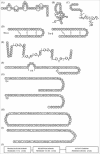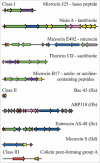Gut microbiota as a source of novel antimicrobials
- PMID: 29584555
- PMCID: PMC6363078
- DOI: 10.1080/19490976.2018.1455790
Gut microbiota as a source of novel antimicrobials
Abstract
Bacteria, Archaea, Eukarya and viruses coexist in the human gut, and this coexistence is functionally balanced by symbiotic or antagonistic relationships. Antagonism is often characterized by the production of antimicrobials against other organisms occupying the same environmental niche. Indeed, close co-evolution in the gut has led to the development of specialized antimicrobials, which is attracting increased attention as these may serve as novel alternatives to antibiotics and thereby help to address the global problem of antimicrobial resistance. The gastrointestinal (GI) tract is especially suitable for finding novel antimicrobials due to the vast array of microbes that inhabit it, and a considerable number of antimicrobial producers of both wide and narrow spectrum have been described. In this review, we summarize some of the antimicrobial compounds that are produced by bacteria isolated from the gut environment, with a special focus on bacteriocins. We also evaluate the potential therapeutic application of these compounds to maintain homeostasis in the gut and the biocontrol of pathogenic bacteria.
Keywords: antibiotic resistance; antimicrobial; bacteriocin; biocontrol; gastrointestinal tract; homeostasis; microbiome; probiotic.
Figures



Similar articles
-
[Bacillus genus bacteria are producers of biologically active compounds with antimicrobial effect].Zh Mikrobiol Epidemiol Immunobiol. 2010 May-Jun;(3):85-9. Zh Mikrobiol Epidemiol Immunobiol. 2010. PMID: 20737685 Review. Russian.
-
Bacillus safensis APC 4099 has broad-spectrum antimicrobial activity against both bacteria and fungi and produces several antimicrobial peptides, including the novel circular bacteriocin safencin E.Appl Environ Microbiol. 2025 Jan 31;91(1):e0194224. doi: 10.1128/aem.01942-24. Epub 2024 Dec 31. Appl Environ Microbiol. 2025. PMID: 39745440 Free PMC article.
-
Gut Distribution, Impact Factor, and Action Mechanism of Bacteriocin-Producing Beneficial Microbes as Promising Antimicrobial Agents in Gastrointestinal Infection.Probiotics Antimicrob Proteins. 2024 Oct;16(5):1516-1527. doi: 10.1007/s12602-024-10222-6. Epub 2024 Feb 6. Probiotics Antimicrob Proteins. 2024. PMID: 38319538 Review.
-
Food and gut originated bacteriocins involved in gut microbe-host interactions.Crit Rev Microbiol. 2023 Aug;49(4):515-527. doi: 10.1080/1040841X.2022.2082860. Epub 2022 Jun 17. Crit Rev Microbiol. 2023. PMID: 35713699 Review.
-
Antimicrobial peptides and gut microbiota in homeostasis and pathology.EMBO Mol Med. 2013 Oct;5(10):1465-83. doi: 10.1002/emmm.201201773. Epub 2013 Aug 23. EMBO Mol Med. 2013. PMID: 24039130 Free PMC article. Review.
Cited by
-
Using Probiotics to Mute Salmonella enteric Serovar Typhimurium: An Opinion.Front Bioeng Biotechnol. 2020 Jun 23;8:558. doi: 10.3389/fbioe.2020.00558. eCollection 2020. Front Bioeng Biotechnol. 2020. PMID: 32656191 Free PMC article. No abstract available.
-
Evaluating the Potential and Synergetic Effects of Microcins against Multidrug-Resistant Enterobacteriaceae.Microbiol Spectr. 2022 Jun 29;10(3):e0275221. doi: 10.1128/spectrum.02752-21. Epub 2022 May 11. Microbiol Spectr. 2022. PMID: 35543514 Free PMC article.
-
Effect of a bacteriocin-producing Streptococcus salivarius on the pathogen Fusobacterium nucleatum in a model of the human distal colon.Gut Microbes. 2022 Jan-Dec;14(1):2100203. doi: 10.1080/19490976.2022.2100203. Gut Microbes. 2022. PMID: 35877697 Free PMC article.
-
From Bench to Bedside: What Do We Know about Imidazothiazole Derivatives So Far?Molecules. 2023 Jun 28;28(13):5052. doi: 10.3390/molecules28135052. Molecules. 2023. PMID: 37446714 Free PMC article. Review.
-
Human gut microbiota-derived antimicrobials against Salmonella Typhi: diversity, mechanisms, and therapeutic potential.Arch Microbiol. 2025 Aug 28;207(10):241. doi: 10.1007/s00203-025-04410-3. Arch Microbiol. 2025. PMID: 40875016 Review.
References
Publication types
MeSH terms
Substances
Grants and funding
- BBS/E/F/00042220/BB_/Biotechnology and Biological Sciences Research Council/United Kingdom
- BB/J004529/1/BB_/Biotechnology and Biological Sciences Research Council/United Kingdom
- BB/J004529/1 /BB_/Biotechnology and Biological Sciences Research Council/United Kingdom
- BBS/E/F/000PR10356/BB_/Biotechnology and Biological Sciences Research Council/United Kingdom
- BBS/E/F/00044453/BB_/Biotechnology and Biological Sciences Research Council/United Kingdom
LinkOut - more resources
Full Text Sources
Other Literature Sources
